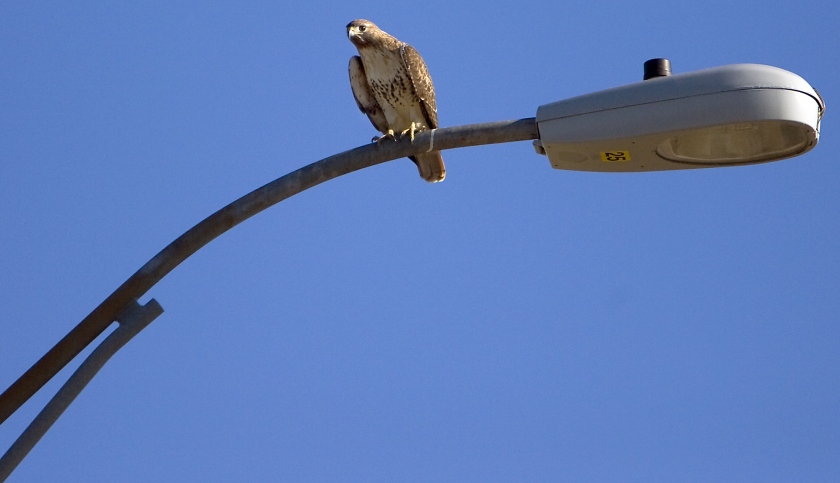
交通噪音:另一个候鸟杀手
Road Noise Takes a Toll on Migrating Birds
交通噪音:另一个候鸟杀手
作者:Christopher Intagliata
翻译:颜旭
审校:王娇娇
Researchers built a "phantom road" through wilderness using tree-mounted speakers to play traffic sounds, and witnessed a decline in bird fitness and diversity. Christopher Intagliata reports
科学家们在野外建造了一条“幻象公路”,将扩音器安装在树上来模拟交通噪音,观察到候鸟的健康水平和多样性均有所降低。
Building a road through wilderness certainly has a visible impact on local flora and fauna—you're physically paving over a slice of what was once habitat. But roads have less obvious effects, too. Like the introduction of traffic noise, which also takes a toll. "You can see an oil spill but you can't see a traffic noise spill. So convincing people that it's important is a little more difficult."
建造一条横穿荒野的公路对当地动植物群落的影响是切实可见的,我们人为地铲平了它们曾经的栖息地。与此同时,还有一些其他不易被察觉的负面影响,比如,交通噪音。“你可以亲眼看见石油泄漏,但是你无法‘看见’交通噪音‘泄漏’。因此想要让人们相信交通噪音的负面影响会更加困难。”
Heidi Ware, an ornithologist at the Intermountain Bird Observatory in Boise, Idaho. She and her colleagues studied the reactions by birds to the sounds of vehicles. And they did it without paving the great outdoors. Instead, they mounted 15 pairs of speakers on Douglas fir trees, along a ridge near Boise, and played traffic noise. <
爱荷华州博伊西市山间观鸟台(Intermountain Bird Observatory)的鸟类学家Heidi Ware和她的同事们研究了鸟类对交通噪音的反应。不过他们并没有真的在户外铺路,而是在荒野中模拟了一条“幻象公路 ”——将30个扩音器沿途安装在博伊西市附近山脊上的一排道格拉斯冷杉上,使得“幻象公路”的噪声比周围森林高了10个分贝。
Turns out just the sounds of traffic scared away a third of the area’s usual avian visitors, and cut species diversity too. And birds of multiple species were not able to pack on as much fat to fuel their migrations, when they were forced to dine to the soundtrack of traffic.
事实证明,这些交通噪音吓跑了三分之一的鸟类来访者,鸟类的多样性也减少了。此外,许多种类的鸟当其被迫在交通噪音中觅食时,是难以获取足够的脂肪以供迁徙所需的。
Follow-up experiments in the lab found that, when it's noisy, birds spend a lot less time head down, pecking at food, and a lot more time scanning their surroundings. "You can imagine if you take away that ability to listen for predators, birds have to compensate by looking around more. It sort of wastes their time, right? Instead of spending their time eating they have to spend their time doing other things." The study is in the journal Proceedings of the National Academy of Sciences. [Heidi E. Ware et al, A phantom road experiment reveals traffic noise is an invisible source of habitat degradation]
随后在实验室进行的研究发现,当外界环境十分嘈杂时,鸟类很少低头啄取食物,而是花费更多的时间来审视周围的环境。“你可以想象,如果你把 鸟类侦听天敌的听觉能力去掉,它必须通过视觉来弥补。这有些浪费时间,不是吗?它们不得不利用进食的时间来做其他的事情。”这项研究已发表在《美国国家科学院学报》(Proceedings of the National Academy of Sciences)(Heidi E. Ware et al, A phantom road experiment reveals traffic noise is an invisible source of habitat degradation)。
Ware says Yosemite, Glacier and Rocky Mountain National Parks all have roads that are busy enough to produce these effects. And, short of closing park roads to traffic, she says things like rubberized asphalt and lower speed limits could help cut the noise. "Glacier National Park is going to put up signs, that instead of showing your speed and preventing people from speeding, it's going to show how loud their car is on the road." Which, hopefully, will continue to encourage wilderness lovers to leave no trace—visible or audible.
Ware说,在美国约塞米提(Yosemite)国家公园、冰河(Glacier)国家公园和落基山(Rocky Mountain)国家公园都建有这样的公路,除了关闭公路,铺设橡胶沥青路面或降低最高限速等措施都有助于减少噪声。“冰河国家公园将会建立指示标牌,这并不是为了指示车速以防止人们超速,而是用来显示他们的车到底产生了多少噪音。”希望这一举措可以继续下去,以鼓励野外爱好者们不要留下任何痕迹,不管是可以看见的还是可以听见的。
未经书面许可任何人不得复制或镜像
京ICP备11000850号-1
 京公网安备11010502039775号
京公网安备11010502039775号 信息网络传播视听节目许可证0111611号
国家科技基础条件平台

















